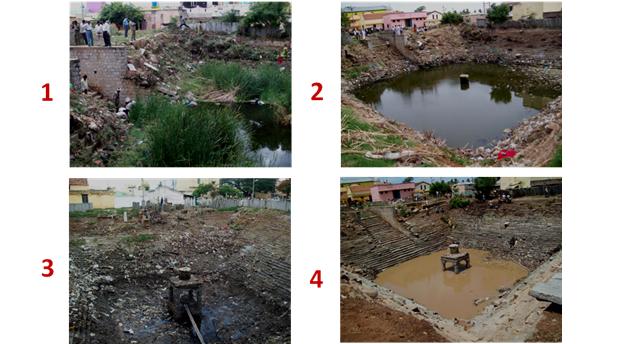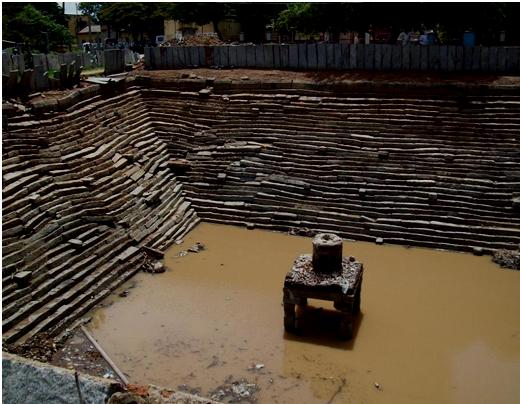Guest post by Manjunath Prasad
As part of the Integrated Urban Water Management (IUWM) initiative at Arghyam, this kalyani that had been abandoned and neglected for the past 25 years was adopted by its own community and transformed in a matter of days.

Before: state of the kalyani just a few weeks ago
Under Arghyam's IUWM programme in Mulbagal, the President, Chief Officer, Project Support Unit (PSU) and Nirmala Balaga formed a special working group to clean up the kalyani through shramadhan (voluntary labour).
The Mulbagal Town Municipal Council (TMC) deployed a tractor, a JCB, 40 pourakarmics with required equipment, 6 Nirmala Balaga staff members and key officers of the TMC and PSU to complete the task.

Clean up work begins on the kalyani
Below is a photo timeline of the progress made by the community.




De-watering the stagnant kalyani
5 pumpsets ranging from 3 to 5 HP capacity were deployed by the Mulbagal TMC to remove the stagnant water in the kalyani. The pumps ran for 90 hours emptying the tank, even revealing a few snakes that had made it their home.

Tanks pumping out stagnant water
The kalyani was also de-weeded, and after all the water had been pumped out an amazing discovery was unearthed - a small structure emerged from the centre of the tank. This structure was identified as a beautiful mantapam, which is believed to be double storied.

Tanks pumping out stagnant water to reveal hidden structure

Mantapam emerges as water level goes down
Extraordinary cooperation from the community was witnessed during this clean up exercise, as is evident from the fact that encroachments on the side of the kalyani that had been there for several decades voluntarily vacated the premises. The Councilor and the Chief Officer are leading from the front on the ground.

Encroachments lining the boundary wall of the kalyani

The journey so far

Groundwater recharging naturally

Relentless and back breaking work at hand
A happy beginning
For over 40 years, this kalyani in Mulbagal was used as a garbage dump. It became a breeding ground for mosquitos, increasing the risk of disease, not to mention that it was an eyesore in the middle of the town. It was a definite source of pollution for the ground water in the area, and became a cosy home for snakes. Not surprisingly, it was also being used for open defecation. There has been a failure on the part of governance, the community and the concerned temple authorities for allowing the kalyani to reach this stage of neglect.
This kalyani can hold approximately 75 lakh litres of water, and there are 26 more similar ones in Mulbagal alone. Today it could cost as much as Rs. 4 crores to construct a kalyani of this size. The tank has started its jouney towards its rejuvenation but still a long way to go. There is a minimum of another 12 to 15 feet depth of silt spread over 50 feet by 50 feet of tank area which can be to an extent of another 1000 tons. In the midst the ground water is coming up complicating the rejuvenation to that extent! But thanks to the enthusiasm of all the stakeholders involved so far and this Kalyani is sure to reach its rejuvenated state. But there are bigger challenges like the Operation and Maintenance of this Kalyani once restored, taking up 26 other kalyanis and 5 big lakes in Mulbagal. All these water bodies can become a lifeline for the town if the same participation from all the stakeholders is channeled towards restoring and maintaining them.
/articles/kalyani-brought-life-mulbagal-karnataka-arghyam-initiative